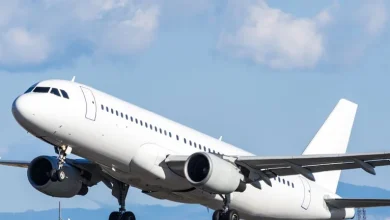Emirates’ Airbus A380 Problem

Emirates is the largest operator of the Airbus A380, but unfortunately, it also has a problem with the jet.
As Airbus has ceased production of the superjumbo, Emirates knows it won’t be acquiring any more units, even after several cancellations that led to the end of the series.
However, Airbus has not ceased production to make way for a new model; instead, there remains no successor and no like-for-like replacement across the industry.
So, what’s the problem precisely for Emirates, how’s it looking to navigate the issue, and what’s next?
The A380 Problem
Emirates’ Airbus A380 problem stems, ironically, from its love for the aircraft and its strong reliance on it.
The Dubai-based carrier has been heavily committed to the program over the years; the jet is its flagship and crucial for transporting passengers to high-demand markets.
However, with jet production having ceased, Emirates is also aware that no replacement exists, as Airbus instead prioritises more efficient twin-engine aircraft for production.
What this means is Emirates, which has over 100 Airbus A380’s in its fleet, is unable to source a direct replacement, whether from Airbus or even competitor Boeing, as both move away from offering something such as this.
Emirates airlines Airbus EADS A380 super jumbo heavy passenger civil airplane A6-EDH takiing off from Dubai International airport
The A380 fleet is now beginning to age, at least by Emirates’ standards, which have long favoured a youthful fleet, rarely keeping aircraft types on for as long as some other airlines do.
Averaging 10.8 years old, the A380 fleet is now starting to show signs of age among some of the older models, which again aligns with how the airline has operated over the years.
Without a direct replacement available and the A380 so crucial to day-to-day flying, Emirates is choosing to retain the jets longer than perhaps originally thought due to the lack of a successor.
The A380neo Talk
With the A380’s retirement incoming and no direct replacement, Emirates has, for now, turned its attention to the prospective A380neo.
The push for the jet has been dramatic, with the airline on several occasions saying it would commit heavily to purchasing the jet if launched and even putting forward its own designs to Airbus in the hopes something would materialise.
An Emirates Airbus A380-800 departs wearing the updated livery released by the carrier
While the jet hasn’t launched, its name alone, the A380neo, hints at improvements over the A380-800; the most noticeable would be the introduction of new engines.
The new engines would aim to deliver better efficiency for operators and therefore address one of the many concerns with the A380-800, and why the jet’s operation deteriorated for some.
While new engines would’ve been the selling point, other improvements would’ve been a priority to bring the model up to speed with newer planes and ensure it would fly for some time longer.
Larger Efficient Aircraft?
After many failed attempts to secure the release of an A380neo from Airbus, Emirates has now shifted its attention to a prospective capacity increase for its existing widebody aircraft families, the A350 and 777X.
A Boeing 777X flight test vehicle taxis out to the runway for a flying display at the 2023 Dubai Airshow – Photo: Coby Wayne
Through reporting in October and comments in Aviation Week’s Daily Memo, Emirates is continuing its push for a larger plane than what is currently on the market, hoping to get Airbus and Boeing to consider its proposals.
Two prospective jets have been touted: the 777-10, a jet that earned technical feasibility in the mid-2010s after internal studies by the American planemaker never progressed.
Next is the A350 Stretch, also known as the A350-2000. This is a further enhancement of the A350-1000 and is aimed at better fending off the 777-9 from the 777X program. If executed, both models would seat comfortably over 400 passengers.
The drive from Emirates for the launch of these models is a direct consequence not only of the lack of A380neo but also of the problem it faces with its aging A380-800 fleet, which will not be around forever and does need replacing.
Emirates passenger airplane Airbus A380-800 registration A6-EDF leaving Swiss Airport Zürich Kloten on a sunny late summer day. – Photo: Michael Derrer Fuchs (shutterstock)
Emirates knows all these things and it’s recent push for a larger twin-engine model comes a s adirect result of understanding that its calls for a new A380 have gone unanswered and will likely continue to, so it must pivot its focus if it stands any chance at getting a model it desires.
What Will Happen?
With Emirates’ calls for the Airbus A380neo going unanswered, and at this stage, no firm movement on the release of a higher-capacity 777X or A350 model, the airline finds itself at a crossroads.
Emirates is currently refurbishing its A380 fleet, alongside its Boeing 777s, in a move that updates the interiors to align with its incoming aircraft, such as the A350 and 777X.
However, this refurbishment allows Emirates to bring the fleet up to the standards of other airlines worldwide while extending the aircraft’s operational life.
Premium Economy on the Emirates Airbus A380
As these Airbus A380 jets continue to age, the airline will only increase maintenance and upkeep, ensuring it can keep the planes in the air for as long as possible, all driven by the lack of available replacements that can perform the same mission.
Under current forecasts and assuming no unforeseen circumstances, Emirates would like to retain its Airbus A380 fleet into the 2040s, likely making it the last operator of the world’s largest passenger plane.
In fitting fashion, the biggest backer of the product throughout its life will likely be the last to fly it, with no second-hand market and no passenger-to-freighter opportunities arising as of yet.
It’s very rare for an airline’s affection for a product to lead directly to a problem as severe, and as the airline sees its operation with the jet enter the twilight stages, it’ll be a time to reflect on what’s next.
20-9-2023, Istanbul, Turkey. Emirates Airbus A380 “A6-EOH” in new livery speeding up on Runway 35R at Istanbul Airport – Photo: MBekir (shutterstock)
For now, without planemakers budging on these ultra-high-capacity, more efficient aircraft models, Emirates will need to move forward with an orderbook and business model that factor in life without the superjumbo.





